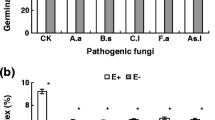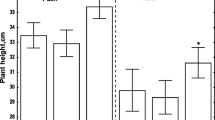Abstract
The activities of enzymes responsible for lignification in pepper, pre-inoculation with arbuscular mycorrhizal (AM) fungus ofGlomus intraradices and/or infection with pathogenic strain ofPhytophthora capsici, and the biological control effect ofG. intraradices on Phytophthora blight in pepper were investigated. The experiment was carried out with four treatments: (1) plants pre-inoculated withG. intraradices (Gi), (2) plants pre-inoculated withG. intraradices and then infected withP. capsici (Gi+Pc). (3) plants infected withP. capsici (Pc), and (4) plants without any of the two microorganisms (C). Mycorrhizal colonization rate was reduced by about 10% in pathogen challenged plants. Root mortality caused by infection ofP. capsici was completely eliminated by pre-inoculation with antagonisticG. intraradices. On the ninth day after pathogen infection, Peroxidase (POD) activity increased by 116.9% in Pc-treated roots but by only 21.2% in Gi+Pc-treated roots, compared with the control, respectively. Polyphenol oxidase (PPO) and Phenylalanine ammonia-lyase (PAL) activities gradually increased during the first 3 d and dramatically decreased in Pc-treated roots but slightly decreased in Gi+Pc-treated roots, respectively. On the ninth day after pathogen infection, PPO and PAL decreased by 62.8% and 73.9% in Pc-treated roots but by only 19.8% and 19.5% in Gi+Pc-treated roots, compared with the control, respectively. Three major POD isozymes (45000, 53000 and 114000) were present in Pc-treated roots, while two major bands (53000 and 114000) and one minor band (45000) were present in spectra of Gi+Pc-treated roots, the 45000 POD isozyme was significantly suppressed byG. intraradices, suggesting that the 45000 POD isozyme was induced by the pathogen infection but not induced by the antagonisticG. intraradices. A 60000 PPO isozyme was induced in Pc-treated roots but not induced in Gi+Pc-treated roots. All these results showed the inoculation of antagonisticG. intraradices alleviates root mortality, activates changes of lignification-related enzymes and induces some of the isozymes in pepper plants infected byP. capsici. The results suggested thatG. intraradices is a potentially effective protection agent againstP. capsici.
Similar content being viewed by others
References
Agrios, G.N., 1997. Plant Pathology. 4th Edition. Academic Press, San Diego, USA, p. 93–114.
Avdiushko, S.A., Ye, X.S., Kuc, J., 1993. Detection of several enzymatic activities in leaf prints of cucumber plant.Physiological and Molecular Plant Pathology,42:441–454.
Azcon-Aguilar, C., Barea, J.M., 1996. Arbuscular mycorrhizas and biological control of soil-borne plant pathogens-an overview of the mechanisms involved.Mycorrhiza,6:457–464.
Blee, K.A., Anderson, A.J., 1996. Defense-related transcript accumulation inPhaseolus vulgaris L. colonized by the arbuscular mycorrhizal fungusGlomus intraradices Schenck & Smith.Plant Physiology,110:675–688.
Borden, S., Higgins, V.J., 2002. Hydrogen peroxide plays a critical role in the defense response of tomato toCladosporicem fulvum.Physiological and Molecular Plant Pathology,61:227–236.
Bradford, M.M., 1976. A rapid sensitive method for quantification of microgram quantities of protein utilizing the principle of protein dye-binding.Analytical Biochemistry.72:48–254.
Breusegem, F.V., Vranova, E., Dat, J.F., Inze, D., 2001. The role of active oxygen species in plant signal transduction.Plant Science,161:405–414.
Brundrett, M.C., Piche, Y., Peterson, R.L., 1984. A new method for observing the morphology of vesicular-arbuscular mycorrhizae.Canadian Journal of Botany,62:2128–2134.
Caruso, C., Chilosi, G., Caporale, C., Leonardi, L., Bertini, L., Magro, P., Buonocore, V., 1999. Induction of pathogenesis-related proteins in germinating wheat seeds infected withFusarium culmorum.Plant Science,140:107–120.
Chen, C.Q., Belanger, R.R., Benhamou, N., Paulitz, T.C., 2000. Defense enzymes induced in cucumber roots by treatment with plant growth-promoting rhizobacteria (PGPR) andPythium aphanidermatum.Physiological and Molecular Plant Pathology,56:13–23.
Cordier, C., Pozo, M.J., Barea, J.M., Gianinazzi, S., Gianinazzi, P.V., 1998. Cell defense response associated with localized and systemic resistance toPhytophthora parasitica induced in tomato by an arbuscular mycorrhizal fungus.Molecular Plant-Microbe Interactions,11(10):1017–1028.
Dassi, B., Dumas, G.E., Gianinazzi, S., 1998. Do pathogenesis-related (PR) proteins play a role in bioprotection of mycorrhizal tomato roots towardsPhytophthora parasitica? Physiological and Molecular Plant Pathology,52:167–183.
Gianinazzi, P.V., Dumas, G.E., Gollotte, A., Tahiri, A.A., Gianinazzi, S., 1996. Cellular and molecular defence-related root responses to invasion by arbuscular mycorrhizal fungus.New Phytologist,133:45–57.
Godwin, B.D., Vaduvatha, S., Nair, P.M., 1996. Stabilization of phenylalanine ammonia-lyase containingRhodotorula glutinis cells for the continuous synthesis of phenylalanine methyl ester.Enzyme and Microbial Technology,19:421–427.
Guenoune, D., Galili, S., Phillips, D.A., Volpin, H., Chet, I., Okon, Y., Kapulnik, Y., 2001. The defense response elicited by the pathogenRhizoctonia solani is suppressed by colonization of VM-fungusGlomus intraradices.Plant Science,160:925–932.
Hammerschmidt, R., 1999. Induced disease resistance: How do induced plants stop pathogens.Physiological and Molecular Plant Pathology,55:77–84.
Harllen, S.A.S., Reginaldo, S.R., Dirceu, M., Bernardo, A.H., Maria, C.B.P., Ann, M., 2004. Rhizobacterial induction of systemic resistance in tomato plants: Non-specific protection and increase in enzyme activities.Biological Control,29:288–295.
Haslan, E., 1983. Shikimic Acid: Metabolism and Metabolites. Wiley, Chichester, UK, p. 50–80.
Jung, W.J., Jin, Y.L., Kim, Y.C., Kim, K.Y., Park, R.D., Kim, T.H., 2004. Inoculation ofPaenibacillus illinoisensis alleviates root mortality, activates of lignification-related enzymes, and induction of the isozymes in pepper plants infected byPhytophthora capsici.Biological Control,30:645–652.
Kilic-Ekici, O., Yuen, G.Y., 2004. Comparison of strains of Lysobacter enzymogenes and PGPR for induction of resistance againstBipolaris sorokiniana in tall fescue.Biological Control,30:446–455.
Koike, N., Hyakumachi, M., Kageyama, K., Tsuyumu, S., Doke, N., 2001. Induction of systemic resistance in cucumber against several diseases by plant growth-promoting fungus: Lignification and superoxide generation.European Journal of Plant Pathology,107:523–533.
Lin, C.C., Kao, C.H., 2001. Cell wall peroxidase activity, hydrogen peroxide level and NaCl-inhibited root growth of rice seedlings.Plant and Soil,230:135–143.
Liu, X.Z., Huang, B.R., 2000. Carbohydrate accumulation in relation to heat stress tolerance in two creeping bent grass cultivars.Journal of American Society for Horticultural Science,125(4):442–447.
Mohammadi, M., Kazemi, H., 2002. Changes in peroxidase and polyphenol activity in susceptible and resistant wheat heads inoculated withFusarium graminearum and induced resistance.Plant Science,162:491–498.
Piyada, T., Michelle, D.H., John, C.S., 1995. Systemic wound induction of potato (Solanum tuberosum) polyphenol oxidase.Phytochemistry,40(3):673–676.
Pozo, M.J., Cordier, C., Dumas-Gaudot, E., Gianinazzi, S., Barea, J.M., Azcon-Aguilar, C., 2002. Localized versus systemic effect of arbuscular mycorrhizal fungus on defense responses to Phytophthora infection in tomato plants.Journal of Experimental Botany,53(368): 525–534.
Ray, H., Douches, D.S., Hammerschmidt, R., 1998. Transformation of potato with cucumber peroxidase: Expression and disease response.Physiological and Molecular Plant Pathology,53:93–103.
Read, D.J., Koucheki, H.K., Hodgson, J., 1976. Vesicular-arbuscular mycorrhiza in native vegetation system.New Phytologist,77:641–653.
Siriphanich, J., Kader, A.A., 1985. Effects of CO2 on cinnamic acid 4-hydroxylase in relation to phenolic metabolism in lettuce tissue.Journal of the American Society for Horticultural Science,110:333–335.
Trotta, A., Varese, G.C., Gnavi, E., Fusconi, A., Sampo, S., Berta, G., 1996. Interaction between the soilborne root pathogenPhytophthora nicotianae var. parasitica and the arbuscular mycorrhizal fungusGlomus mosseae in tomato plants.Plant and Soil,185:199–209.
Zheng, H.Z., Kim, Y.W., Lee, H.J., Park, R.D., Jung, W.J., Kim, Y.C., Lee, S.H., Kim, T.H., Kim, K.Y., 2004. Quantitative changes of PR proteins and antioxidant enzymes in response toGlomus intraradices andPhytophthora capsici in pepper (Capsicum annuum L.) plants.Journal of Microbiology and Biotechnology,14(3):553–562.
Author information
Authors and Affiliations
Additional information
Project supported by Korea Science and Engineering Foundation (KOSEF) through the Agricultural Plants Stress Research Center (APSRC) at Chonnam National University, Korea
Rights and permissions
About this article
Cite this article
Hu-zhe, Z., Chun-lan, C., Yu-ting, Z. et al. Active changes of lignification-related enzymes in pepper response toGlomus intraradices and/orPhytophthora capsici . J. Zheijang Univ.-Sci. B 6, 778–786 (2005). https://doi.org/10.1007/BF02842437
Received:
Accepted:
Issue Date:
DOI: https://doi.org/10.1007/BF02842437
Key words
- Arbuscular mycorrhizal (AM) fungus
- Glomus intraradices
- Phytophthora capsici
- Peroxidase (POD)
- Polyphenol oxidase (PPO)
- Phenylalanine ammonia-lyase (PAL)




